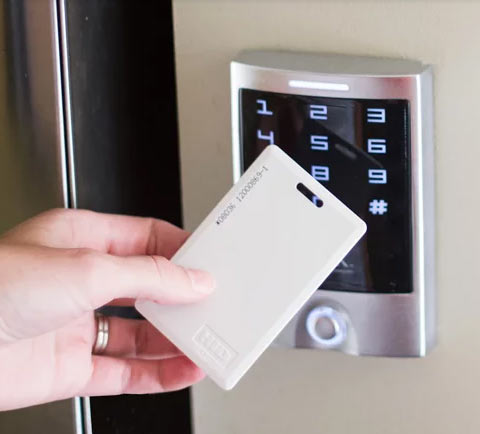OwnerGo Integration With PDK Access Control Case Study

How all the stakeholders of an Atlanta condominium community benefit from the innovative combination of access control and lease management platforms.
Residential property managers know that making everyone happy is never easy. When it comes to finding appropriate management technologies, the route can be clogged with the diverse needs of stakeholders, including maintenance, communication, collaboration, governance, finances and administrative efficiency. However, some needs—security, for example—cannot be left unattended.
A system that provides ease of use, flexible tools, permissions based on user type, and affordable installation and maintenance costs offers strong value to property owners, tenants and management associations alike. Even better is an access control solution that integrates seamlessly with other software tools to provide a single, integrated platform that can fulfill the myriad needs of multi-tenant properties.
An example of one highly functional solution is in operation at Freedom Heights and Lofts, a condominium community located in a quasi-urban section of Atlanta, Georgia. The community totals 245 residential units in two modern buildings and another structure dating to 1940 that was converted to lofts. Freedom Lofts Condominium Association manages all three buildings and a parking structure.
The Security Challenge
As of about five years ago, despite its upscale aesthetic and highly desirable location, Freedom Heights and Lofts was, by its own admission, ineffectively battling trespassing, break-ins, and other crimes with an antiquated access control system that was no longer supported by the manufacturer.
The system, which secured more than 30 entry points, lacked a centralized server to record and preserve door-use data. Ken Gwinner, who is currently the President of the Home Owners Association board and was serving a previous term on the HOA board at the time, explains, "To enter the complex, residents were issued "clickers—kind of like garage door openers." Because there was no way to remotely disable the clickers, when one was lost or stolen it could be used by anyone to access the entire property. During that time period, it was suspected that a rash of breaks-ins were committed by criminals who used stray clickers.
At the same time, many of the clickers had reached their end of lifecycle and replacements were no longer available. This spurred the HOA board to search for a new system, including a thorough vendor and technology analysis. Due to the sprawling layout of the property, it was determined that wiring an Ethernet-based system would cost an estimated $70,000 to $100,000.
"With the 32 access points that we had to connect, which included all of the exterior doors and gates to get into the buildings as well as the parking garage and common areas, like laundry rooms and the pool, the system would have been prohibitively expensive," Gwinner says.
Eventually, the HOA board selected a solution by ProdataKey (PDK) of Draper, Utah, that allowed the access points to be connected in an innovative wireless mesh network across the property's expanse. "We were looking at savings of around $65,000 by going with PDK. That was a huge win for us," Gwinner states. It also has powerful management capabilities, including robust reporting, the ability to limit access by building only to its respective residents, and a mobile interface that allows the night security guard to see, at a glance, if any secure doors have been left propped open. Plus, when a card is reported lost, it can be quickly deactivated.
Who Gets Access?
If all of the units in the complex were owner-occupied, it would have been a relatively straightforward process to distribute several cards or fobs to each of the homeowners and consider the project complete. However, only about three quarters of the units are owner-occupied, and this is where security concerns converge with other property management challenges.
Gwinner explains that as a condominium complex, a maximum of 25% of their total units can be legally leased out at any given time. As such, there is a perpetual waiting list of owners who want to lease out their units but don't have permission to do so.
Historically, the task of maintaining the waiting list was assigned to the overburdened property manager, who used a simple spreadsheet to keep track of tenants and prospective renters. Many homeowners learned, over time, that they didn't need to follow the rules, because of the lack of transparency in the process and lack of enforcement. As a result, illegal and – from the HOA's perspective – anonymous residents became plentiful.
In 2010, long before the PDK installation, HOA board member and IT expert, Kyle Montgomery, created a bespoke database to keep track of these problematic, but important rental lists. "There were software solutions out there, but frankly, I didn't think they were implemented well and wouldn't really make things more efficient for us while managing our community," Montgomery explains.
Ultimately, Montgomery expanded the original database, combining it with other functionalities, to create OwnerGo, a cloud-based software platform for HOAs that not only keeps track of leasing documentation, but also features a range of tools to support the member community, including event calendars, online work order submissions, resident directories, online payment processing and more. OwnerGo also has a completely automated leasing list tool for use by HOAs—a unique feature of OwnerGo not found on other products.
"It keeps associations and property management companies responsive to residents and gives managers and board members the tools they need to function more efficiently," Montgomery states of his product. "Integrating PDK's access control capabilities into the platform was an extension that could enhance security and convenience for all involved."
Bringing It Together
About a year ago, the complex upgraded to PDK's newest cloud-based solution, PDK io. At this point, Montgomery's vision was possible. "Because both OwnerGo and PDK systems are cloud-based and have an open API, it was easy to create a seamless integration. It didn't take long; we had it done by January 2019."
"Kyle Montgomery was able to pull in a lot of our features into the interface," notes Cory Jackson, Vice President of Sales for PDK. "From the residents' perspective, everything that PDK is doing to manage and deliver security is a seamless part of OwnerGo's capabilities. The best example of this is mapping, where we can graphically show the location of controlled doors on a floor plan within the OwnerGo web or mobile interfaces."
The maps feature allows users to unlock the doors for which they have permission without the need for a physical access control card. This also makes it possible for residents to open doors remotely for visitors, who can call ahead from outside.
All of this is a tremendous improvement to capabilities before the integration, when there was one system to organize the community and a separate one to keep it safe. "The property manager had to navigate and manage the two separately. When new residents moved into the building, he had to keep track of access control cards they were issued in OwnerGo and in PDK io—and keeping the databases synchronized was hard to do manually," says Montgomery.
"System users are defined by groups. Residents can only open doors in their own building and common areas to which they should have access. Now, when an access control card is lost or stolen, residents can log into the OwnerGo portal to see the card numbers they've been assigned, figure out which one is missing and request that it be deactivated – either permanently or until it shows up. There's no concern about it circulating somewhere outside the community and providing access to someone who shouldn't be coming into the building," he explains.
Jackson adds, "PDK's pricing is based upon a per-door annual fee–not on number of users. This gives the HOA freedom to issue as many cards as residents want without affecting the price."
Additionally, says Montgomery, "OwnerGo is designed to reduce data entry by the property manager. It manages cards automatically, so cards assigned to a particular unit are transferred automatically to the next occupant, unless the property manager wants to change the cards assigned. Homeowners and residents can onboard themselves to the system by registering at OwnerGo.com where the manager only needs to approve the registration, or a property manager can enter new resident information directly."
Delivering Beyond Security
The PDK solution has proven its value in expected and unexpected ways.
In terms of traditional applications, the system was instrumental in solving the mystery of disappearing packages, which occurred a few years back before the complex installed its new package locker system.
Gwinner says that "we had a spate of package thefts from the mailbox area, which was in a secure area controlled by the PDK system. We were able to use PDK's reporting to see who had come and gone, at what times, and then view correlating video footage from our security cameras. It turns out that a tenant was the thief."
A more unusual use for the system has been to help the HOA board collect delinquent payment of condo fees. Gwinner explains that "Previously, we didn't have much leverage to make these residents pay—and it could be a lot money that was owed. Now, if their balance goes above a certain amount, we can restrict their access so that they're locked out of the parking garage, fitness center, or the pool. This has worked really well. We had one delinquent resident who owed $8,000, and he loved to swim. We cut off his access to the pool and now he's all paid up. It's a powerful tool."
"I would definitely recommend the OwnerGo/PDK solution to Homeowner Associations, property management companies and other entities responsible for the many challenges associated with properties like ours. Because it was designed by someone who was actually on our board, Kyle knew the problems we were facing and he's created something that does exactly what we need."
It turns out that sometimes, it is possible to keep everyone happy, afterall.
Posted by Kyle Montgomery

Kyle is the founder of OwnerGo and writes regularly to help homeowners, managers, and board members streamline their community operations. He has 15 years' experience working in the data processing sector, working with hundreds of companies to help automate financial, human resources, and material management data. He has spent 6 years as a board member of his home owners' association, which had an annual budget of over $800,000. He currently lives in New York City.